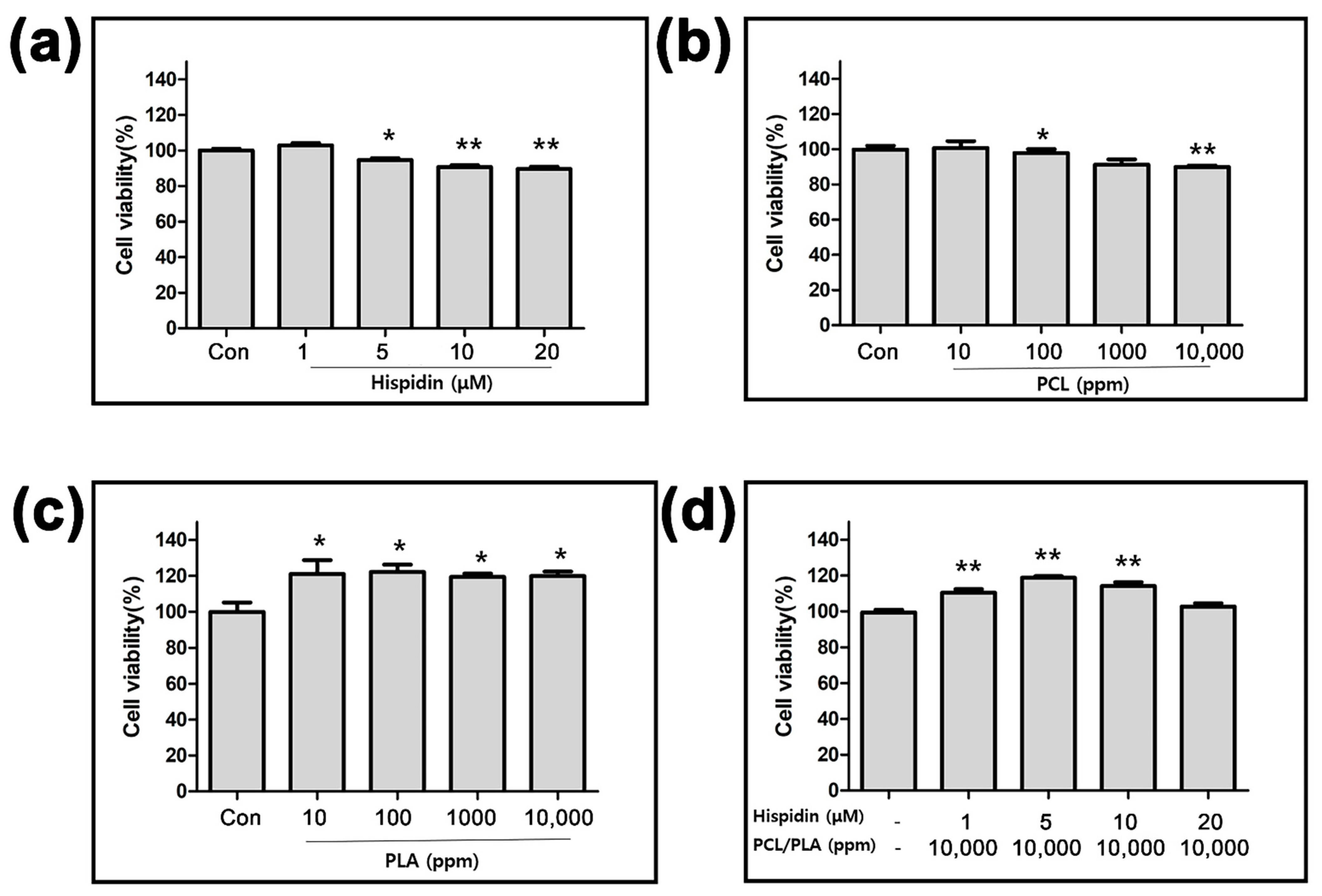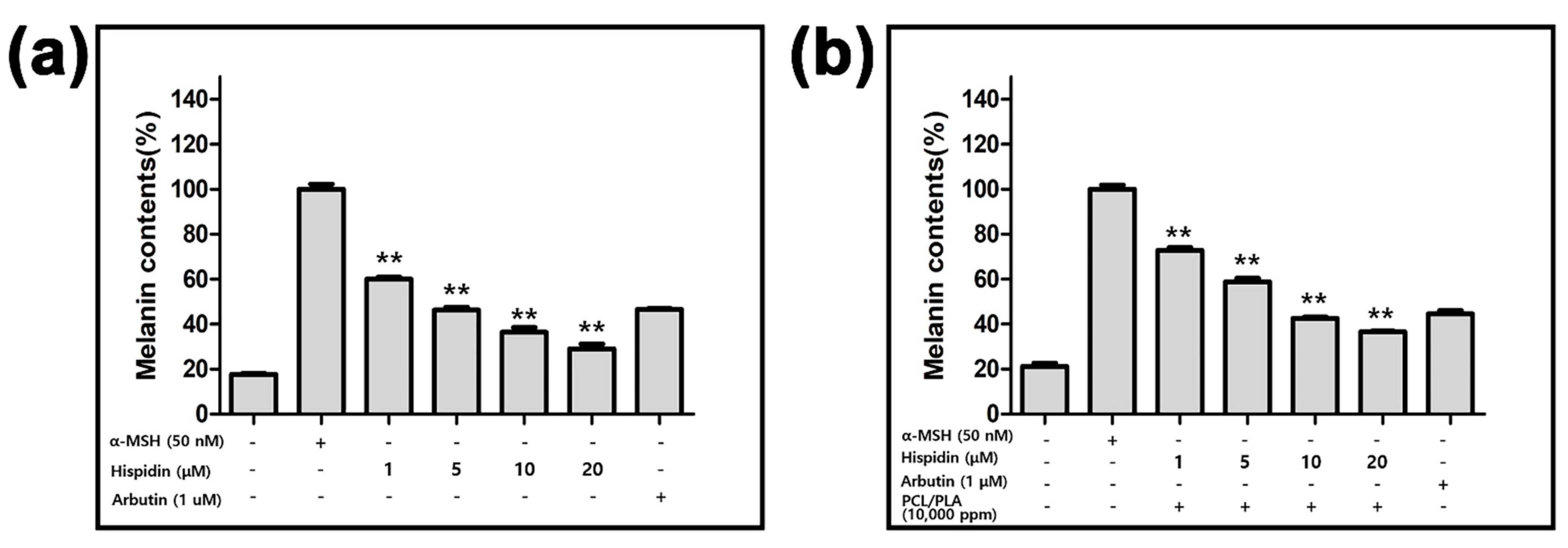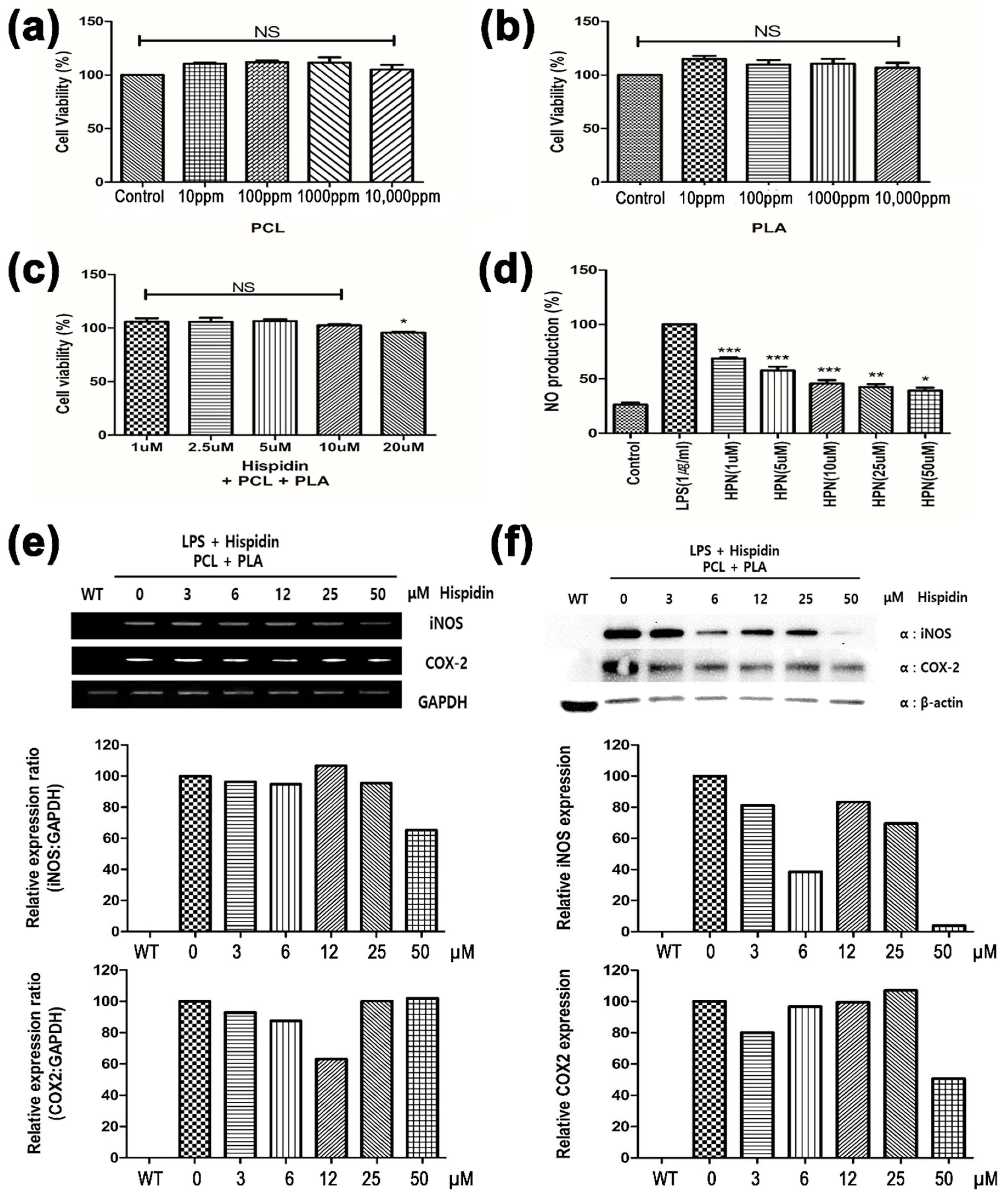Polylactic Acid and Polycaprolactone Blended Cosmetic Microneedle for Transdermal Hispidin Delivery System
Abstract
1. Introduction
2. Materials and Methods
2.1. Materials
2.2. Fabrication of MNs
2.3. Characterization
3. Results and Discussion
3.1. Microstructure and Mechanical Strength of MNs
3.2. Hispidin Delivery Test
3.3. Cell Viability Test with Hispidin, PCL, PLA, and Mixture
3.4. Brightening Test with Hispidin, PCL, PLA, and Mixture
3.5. Anti-Inflammatory Test
3.6. Antibacterial Activity by Paper Disc Method
4. Conclusions
Author Contributions
Funding
Institutional Review Board Statement
Informed Consent Statement
Conflicts of Interest
References
- Prausnitz, M.R.; Langer, R. Transdermal drug delivery. Nat. Biotechnol. 2008, 26, 1261–1268. [Google Scholar] [CrossRef] [PubMed]
- Gupta, M.; Agrawal, U.; Vyas, S.P. Nanocarrier-based topical drug delivery for the treatment of skin diseases. Expert Opin. Drug Deliv. 2012, 9, 783–804. [Google Scholar] [CrossRef] [PubMed]
- Ita, K. Transdermal Delivery of Drugs with Microneedles-Potential and Challenges. Pharmaceutics 2015, 7, 90–105. [Google Scholar] [CrossRef] [PubMed]
- Bora, P.; Kumar, L.; Bansal, A.K. Microneedle Technology for Advanced Drug Delivery: Evolving Vistas. CIRPS 2008, 9, 7–10. [Google Scholar]
- Williams, A.C.; Barry, B.W. Penetration enhancers. Adv. Drug Deliv. Rev. 2004, 56, 603–618. [Google Scholar] [CrossRef] [PubMed]
- Sharma, D. Microneedles: An Approach in Transdermal Drug Delivery: A Review. Pharma Tutor 2018, 6, 7–15. [Google Scholar] [CrossRef]
- Akhtar, N. Microneedles: An Innovative Approach to Transdermal Delivery—A Review. Int. J. Pharm. Pharm. Sci. 2014, 6, 18–25. [Google Scholar]
- Li, J.; Zeng, M.; Shan, H.; Tong, C. Microneedle Patches as Drug and Vaccine Delivery Platform. Curr. Med. Chem. 2017, 24, 2413–2422. [Google Scholar] [CrossRef] [PubMed]
- Prausnitz, M.R. Engineering Microneedle Patches for Vaccination and Drug Delivery to Skin. Annu. Rev. Chem. Biomol. Eng. 2017, 8, 177–200. [Google Scholar] [CrossRef] [PubMed]
- Suzuki, M.; Takahashi, T.; Aoyagi, S. 3D laser lithographic fabrication of hollow microneedle mimicking mosquitos and its characterization. Int. J. Nanotechnol. 2018, 15, 157–173. [Google Scholar] [CrossRef]
- Cheung, K.; Han, T.; Das, D.B. Effect of force of microneedle insertion on the permeability of insulin in skin. J. Diabetes Sci. Technol. 2014, 8, 444–452. [Google Scholar] [CrossRef] [PubMed]
- Tu, P.T.B.; Chompoo, J.; Tawata, S. Hispidin and related herbal compounds from Alpinia zerumbet inhibit both PAK1-dependent melanogenesis in melanocytes and reactive oxygen species (ROS) production in adipocytes. Drug Discov. Ther. 2015, 9, 197–204. [Google Scholar]
- Han, Y.H.; Chen, D.Q.; Jin, M.H.; Jin, Y.H.; Li, J.; Shen, G.N.; Li, W.L.; Gong, Y.X.; Mao, Y.Y.; Xie, D.P.; et al. Anti-inflammatory effect of hispidin on LPS induced macrophage inflammation through MAPK and JAK1/STAT3 signaling pathways. Appl. Biol. Chem. 2020, 63, 1–9. [Google Scholar] [CrossRef]
- Park, J.M.; Lee, J.S.; Song, J.E.; Sim, Y.C.; Ha, S.J.; Hong, E.K. Cytoprotective effect of hispidin against palmitate-induced lipotoxicity in C2C12 myotubes. Molecules 2015, 20, 5456–5467. [Google Scholar] [CrossRef] [PubMed]
- Maruta, H.; Tu, P.T.B.; Mok-Ryeon, A. Natural or Synthetic Anti-Melanogenic Compounds That Block the PDGFR-EGFR-PAK1-MITF-Tyrosinase Signaling Pathway. J. Dermatol. Res. Ther. 2017, 3, 48. [Google Scholar]
- Gribble, G.W. Progress in the Chemistry of Organic Natural Products, 1st ed.; Springer: Berlin, Germany, 1996; pp. 1–423. [Google Scholar]
- Chen, W.; He, F.Y.; Li, Y.Q. The apoptosis effect of hispolon from Phellinus linteus (Berkeley & Curtis) Teng on human epidermoid KB cells. J. Ethnopharmacol. 2006, 105, 280–285. [Google Scholar] [PubMed]
- Lee, Y.S.; Kang, Y.H.; Jung, J.Y.; Lee, S.; Ohuchi, K.; Shin, K.H.; Kang, I.J.; Park, J.H.; Shin, H.K.; Lim, S.S. Protein glycation inhibitors from the fruiting body of Phellinus linteus. Biol. Pharm. Bull. 2008, 31, 1968–1972. [Google Scholar] [CrossRef] [PubMed]
- Halliwell, B.; Gutteridge, J.M. Oxygen toxicity, oxygen radicals, transition metals and disease. Biochem. J. 1984, 219, 1–14. [Google Scholar] [CrossRef] [PubMed]
- Shao, H.J.; Jeong, J.B.; Kim, K.J.; Lee, S.H. Anti-inflammatory activity of mushroom-derived hispidin through blocking of NF-κB activation. J. Sci. Food Agric. 2015, 95, 2482–2486. [Google Scholar] [CrossRef] [PubMed]
- Zhang, D.; Das, D.B.; Rielly, C.D. Microneedle assisted micro-particle delivery from gene guns: Experiments using skin-mimicking agarose gel. J. Pharm. Sci. 2014, 103, 613–627. [Google Scholar] [CrossRef] [PubMed]
- Murray, P.R.; Jo, E.; Turnidge, B. Manual of Clinical Microbiology, 9th ed.; ASM Press: Washington, DC, USA, 2007; pp. 1152–1172. [Google Scholar]
- Xu, B.; Zhu, D.; Yin, D.; Jin, Q.; Gao, S.; Zhao, J. Pyramid-Shaped Tips Based Polymer Microneedles for Transdermal Drug or Nanoparticle Delivery. In Proceedings of the 2007 7th IEEE Conference on Nanotechnology (IEEE NANO), Hong Kong, China, 2–5 August 2007; pp. 287–290. [Google Scholar]






| Treatments | Con. (µM) | Size of Clear Zone (mm) | |||
|---|---|---|---|---|---|
| Staphylococcus epidermidis | Escherichia coli | Pseudomonas aeruginosa | Staphylococcus aureus | ||
| Hispidin | 20 | 0.5 | 0.4 | 0.5 | 0.4 |
| Hispidin | 10 | 0.4 | 0.4 | 0.4 | - |
| Hispidin | 5 | - | - | - | - |
| Hispidin | 1 | ||||
| 70% EtOH (1) | - | 0.6 | 0.6 | 0.6 | 0.6 |
| Sterilized DW (2) | - | - | - | - | - |
Publisher’s Note: MDPI stays neutral with regard to jurisdictional claims in published maps and institutional affiliations. |
© 2021 by the authors. Licensee MDPI, Basel, Switzerland. This article is an open access article distributed under the terms and conditions of the Creative Commons Attribution (CC BY) license (http://creativecommons.org/licenses/by/4.0/).
Share and Cite
Lee, S.; Lee, J.; Choi, K.; Kim, H.; Park, Y.; Yoon, J.; Kim, J.H.; Ryu, S. Polylactic Acid and Polycaprolactone Blended Cosmetic Microneedle for Transdermal Hispidin Delivery System. Appl. Sci. 2021, 11, 2774. https://doi.org/10.3390/app11062774
Lee S, Lee J, Choi K, Kim H, Park Y, Yoon J, Kim JH, Ryu S. Polylactic Acid and Polycaprolactone Blended Cosmetic Microneedle for Transdermal Hispidin Delivery System. Applied Sciences. 2021; 11(6):2774. https://doi.org/10.3390/app11062774
Chicago/Turabian StyleLee, Seungyeon, Jihye Lee, Kanghyun Choi, Hyoseon Kim, Youngkum Park, Juhee Yoon, June Hyun Kim, and Seongwoo Ryu. 2021. "Polylactic Acid and Polycaprolactone Blended Cosmetic Microneedle for Transdermal Hispidin Delivery System" Applied Sciences 11, no. 6: 2774. https://doi.org/10.3390/app11062774
APA StyleLee, S., Lee, J., Choi, K., Kim, H., Park, Y., Yoon, J., Kim, J. H., & Ryu, S. (2021). Polylactic Acid and Polycaprolactone Blended Cosmetic Microneedle for Transdermal Hispidin Delivery System. Applied Sciences, 11(6), 2774. https://doi.org/10.3390/app11062774






